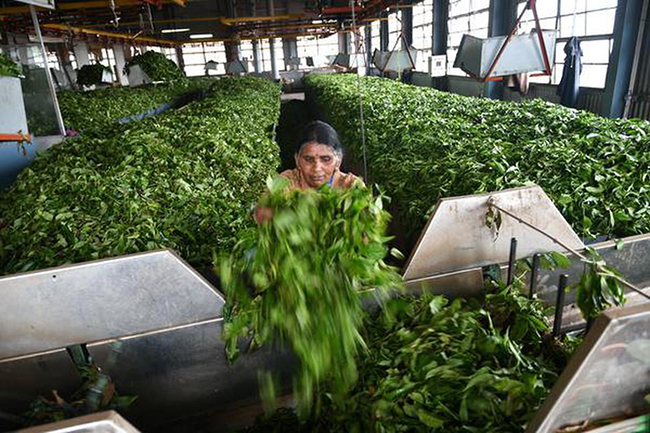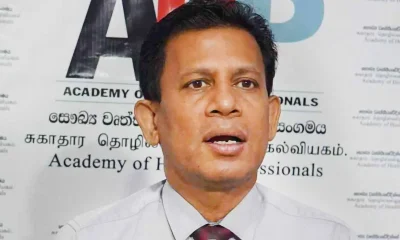News
SL looking at mechanical tea harvesting to combat labour scarcity

by Chanka Jayasinghe
Sri Lanka’s Tea Board, fearing labor shortages, has initiated mechanized tea harvesting with no quality or production loss expected, E.A.J.K. Edirisinghe, Commissioner of the Tea Board said He said the Tea Research Institute (TRI) has already carried out research collaborating with Japan, and identified that efficiency can be improved, while preserving the same production capacity in estates.
“Machine plucking and hand plucking are two different techniques. When you do hand plucking only, the best buds will be plucked. When plucking by machine, we will train the bush for the machine by grooming it,” Edirisinghe told reporters at a media briefing last week. “Then every 15 days, there will be new buds because of the way we groomed the bush.”
He said currently 55 lands in each TRI division have been cultivated with a mechanized tea harvesting model and the cultivators are asked to grow their tea according to the new model.
However, in a publication last year, the TRI mentioned that none of the mechanized harvesting machines tested in Sri Lanka could harvest tea leaves selectively, leaving tender shoots on the bush.
The harvested crop contained mature foliage and twigs etc. which had be removed by manual sorting.Average output of machines is in the range between 50 (small machines) and 350 (large machines) kg/day. But, the sorting and cleaning process need more labor, industry experts say.Machine plucking extends the frequency of harvesting (plucking round) due to non-selective harvesting of leaf. Industry experts say tea yield under mechanical harvesting could fall 30-50 percent in comparison to manual harvesting.
Officials from Planters Association of Ceylon have said machine tea harvesting was tested, but it cannot be implemented in Sri Lanka due to the damage it does to the bush.However, tea board officials said no production will be lost if the bush is first groomed to suit mechanized harvesting.
“If you harvest a previously hand plucked bush by machine, then yes the damage will be great and yes there will be a drop around 20-30 percent,” Edirisinghe said.
“But when you start plucking after grooming, the buds will break on the plucking surface and there will be no damage,” he said, adding that countries like Kenya, Japan and Malaysia use the method without any drop in quality and quantity.Tea Board and Tea Small Holding Development Authority (TSHDA) will provide 437,000 rupees per acre of tea land for those who follow the new model along with a special irrigation system.
“That does not mean hand plucking will be stopped. When there is no labour, we can use machines,” Edirisinghe said.
“The reason why we are doing this is if we ever have to go for mechanical harvesting, then we will have to remove existing plantation and plant anew to adapt to the new order. (Economy Next)
Latest News
Interment of singer Latha Walpola at Borella on Wednesday [31st]

Family sources have confirmed that the interment of singer Latha Walpola will be performed at the General Cemetery Borella on Wednesday (31 December).
News
Western Naval Command conducts beach cleanup to mark Navy’s 75th anniversary

In an environmental initiative commemorating the 75th anniversary of the Sri Lanka Navy, the Western Naval Command organized a cleanup programme at Galle Face Beach on Saturday (27 Dec 25).
The programme focused on the removal of substantial solid waste littering the beachfront, including accumulated plastic and polythene debris. All collected wastey was systematically disposed of utilizing methods designed to safeguard the sensitive coastal ecosystem.
Demonstrating a strong commitment to the cause, the cleanup effort saw the participation of the Commander Western Naval Area and a group of over 200 naval personnel.
News
Environmentalists warn Sri Lanka’s ecological safeguards are failing

Sri Lanka’s environmental protection framework is rapidly eroding, with weak law enforcement, politically driven development and the routine sidelining of environmental safeguards pushing the country towards an ecological crisis, leading environmentalists have warned.
Dilena Pathragoda, Managing Director of the Centre for Environmental Justice (CEJ), has said the growing environmental damage across the island is not the result of regulatory gaps, but of persistent failure to enforce existing laws.
“Sri Lanka does not suffer from a lack of environmental regulations — it suffers from a lack of political will to enforce them,” Pathragoda told The Sunday Island. “Environmental destruction is taking place openly, often with official knowledge, and almost always without accountability.”
Dr. Pathragoda has said environmental impact assessments are increasingly treated as procedural formalities rather than binding safeguards, allowing ecologically sensitive areas to be cleared or altered with minimal oversight.
“When environmental approvals are rushed, diluted or ignored altogether, the consequences are predictable — habitat loss, biodiversity decline and escalating conflict between humans and nature,” Pathragoda said.
Environmental activist Janaka Withanage warned that unregulated development and land-use changes are dismantling natural ecosystems that have sustained rural communities for generations.
“We are destroying natural buffers that protect people from floods, droughts and soil erosion,” Withanage said. “Once wetlands, forests and river catchments are damaged, the impacts are felt far beyond the project site.”
Withanage said communities are increasingly left vulnerable as environmental degradation accelerates, while those responsible rarely face legal consequences.
“What we see is selective enforcement,” he said. “Small-scale offenders are targeted, while large-scale violations linked to powerful interests continue unchecked.”
Both environmentalists warned that climate variability is amplifying the damage caused by poor planning, placing additional strain on ecosystems already weakened by deforestation, sand mining and infrastructure expansion.
Pathragoda stressed that environmental protection must be treated as a national priority rather than a development obstacle.
“Environmental laws exist to protect people, livelihoods and the economy,” he said. “Ignoring them will only increase disaster risk and long-term economic losses.”
Withanage echoed the call for urgent reform, warning that continued neglect would result in irreversible damage.
“If this trajectory continues, future generations will inherit an island far more vulnerable and far less resilient,” he said.
Environmental groups say Sri Lanka’s standing as a biodiversity hotspot — and its resilience to climate-driven disasters — will ultimately depend on whether environmental governance is restored before critical thresholds are crossed.
By Ifham Nizam ✍️
-

 News5 days ago
News5 days agoMembers of Lankan Community in Washington D.C. donates to ‘Rebuilding Sri Lanka’ Flood Relief Fund
-

 News3 days ago
News3 days agoBritish MP calls on Foreign Secretary to expand sanction package against ‘Sri Lankan war criminals’
-

 News6 days ago
News6 days agoAir quality deteriorating in Sri Lanka
-

 News6 days ago
News6 days agoCardinal urges govt. not to weaken key socio-cultural institutions
-

 Features5 days ago
Features5 days agoGeneral education reforms: What about language and ethnicity?
-

 Opinion6 days ago
Opinion6 days agoRanwala crash: Govt. lays bare its true face
-

 News5 days ago
News5 days agoSuspension of Indian drug part of cover-up by NMRA: Academy of Health Professionals
-

 News6 days ago
News6 days agoCID probes unauthorised access to PNB’s vessel monitoring system













